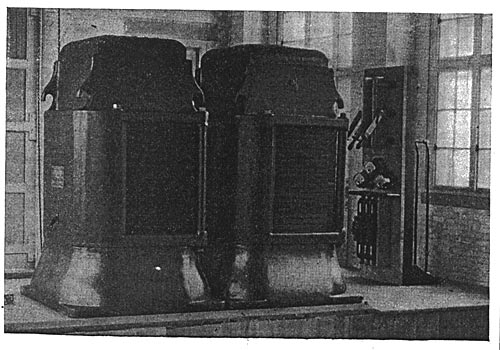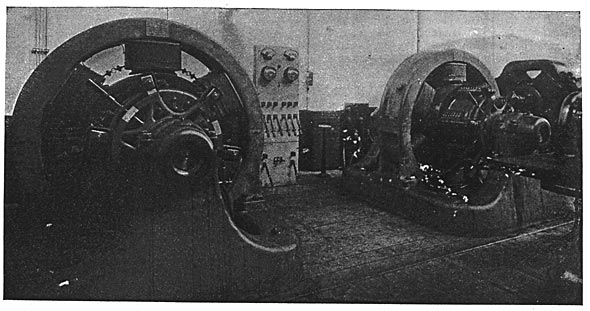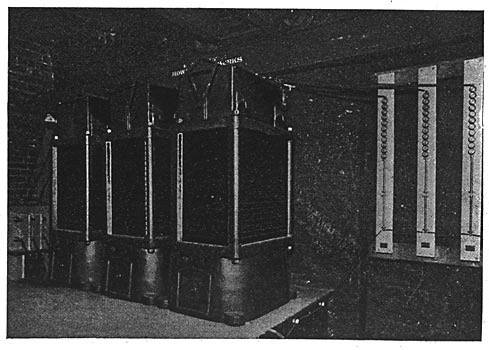[Trade Journal]
Publication: Electrical Doings
New York, NY, United States
vol. 1, no. 9, p. 6, col. 1-4
NIAGARA CURRENT IN BUFFALO.
The Equivalent of 1,000 Horse-Power
Transmitted for the First Time on
November 15 — The Huge Step-Up
and Step-Down Transformers
— Provisions Made for Sending
40,000 Horse-Power
Over the Same
Course.
A Crucial Transmission Trial.
BY E. H. MULLIN.
The first long distance transmission of electricity from Niagara Falls was formally opened at midnight on Sunday, November 15, when a current equal to 1,000 horse-power was sent from the transformer house of the Niagara Falls Power Company to Buffalo, twenty-six miles away.
This current has since been feeding into the main switchboard of the Buffalo Street Railway Company, uniting there with the current generated in the local power house. It is intended ultimately to transmit a current equal to 40,000 horse-power over this line, and the experiment will be watched with interest by electricians all over the world, as its success will establish the supremacy of waterfall current over steam generated current within a radius of at least twenty-five miles from the generating house. The test in Buffalo is under peculiarly unfavorable conditions, as the cost of good steam coal there is only $1.50 a ton.
| |||
| Step-Up Transformers at the Niagara End. |
Before the erection of the line was begun the Cataract Power and Conduit Company secured a right of way consisting of a strip of land thirty feet wide in which to erect their poles, so that they would not be on the highways or in any place where danger might follow any accident to the line.
After this had been done white cedar poles, varying from thirty-five to sixty-five feet in height, were planted in the ground at a distance of about seventy feet apart from each other. For some the clayey ground was a sufficient anchorage, but in other cases, where the earth was soft, the poles are planted in a bed of concrete. Owing to the refusal of some of the farmers to give up a strip in the centre of their farms, the line had necessarily to be made very crooked, since it often followed the fences. Where sharp turns were made double poles were erected and the cross arms stretched between them. These cross arms are twelve feet long and five inches square, and they are attached to the poles by solid braces of angle iron. Each pole carries two of these large cross arms, and one smaller one which is to be used for the telephone wire.
On each side of each cross arm are three wooden pins, on which are screwed heavy porcelain insulators weighing about ten pounds a piece. These insulators are hollowed out underneath into two deep circular grooves, which are intended to keep their under surface dry in all weathers, so that the electricity will have no chance to escape down the poles in damp weather.
| |||
| Rotary Converter in the Buffalo Street Railway's Power House. |
On the top of each of these insulators is a deep longitudinal groove through which passes the copper wire which is to carry its share of the current. As the electricity is transmitted by the three-phase system there are three of these wires, each about one-third of an inch in diameter. This system was adopted because it gives the greatest economy of copper in the line. Dr. Louis Duncan, president of the American Institute of Electrical Engineers, in a paper read by him last month, calculated that the three-phase system only required three-quarters the quantity of copper which would be necessary in the two-phase Tesla system by which the current is generated at Niagara. As a single mile of this wire weighs 5,600 pounds and the total length is twenty-six miles, it is a simple matter of calculation to show that the saving of copper in this case was 67.6 tons.
When the line approaches the city of Buffalo, which it does along the Erie canal, it is changed from overhead to underground, and the last 4,200 feet of this wire, now fully insulated with rubber and armored with lead, go through ducts of vitrified tile each three inches in diameter. There are altogether twelve of these ducts, of which only three are to be used at first, laid in a trench and surrounded with four inches of concrete on all sides. Besides the concrete the public has also the advantage of eighteen inches of solid earth between their feet and the top of the concrete.
The most remarkable feature of this line is the high voltage at which the current will be transmitted. Nearly every one nowadays understands that voltage simply means electrical pressure. It would not matter much for short distances whether a large quantity of electricity be sent over a wire at low voltage or pressure, or a small quantity at high pressure — the total amount of electricity delivered in a given time would be the same. But in long distance transmission a low voltage means such a constant loss of the current through leakage, heat and other more obscure electrical causes that its use is prohibitive. Therefore, to transmit any quantity of power over long distance without an appalling cost for copper wire, a high voltage system must be adopted.
The pressure of electricity in the ordinary incandescent lamp is no volts; the pressure used in the trolley systems never exceeds 600 volts; the pressure on the line between Niagara and Buffalo will be 11,000 volts at the start, and provision is made for increasing this pressure to 22,000 volts as soon as the additional quantity of electricity is required.
| |||
| Step-Down Transformers at the Buffalo End. |
The current generated by the great dynamos at Niagara Falls comes out at a pressure of 2,200 volts. By what is known as a step-up transformer, which is simply a coil of fine insulated wire surrounding a shorter coil of coarse insulated wire, the voltage is at once increased to 11,000 volts. At this pressure the current takes the wires and follows them to the receiving station in Buffalo. Here it enters a step-down transformer, which is the opposite of that in which the pressure is raised, and the voltage is lowered to 440 volts.
It must be remembered that the current up to this point has been an alternating one, being generated as a two-phase alternating current and changed to a three-phase current in the step-up transformers for transmission on the wires. It is now necessary, in order to harmonize it with the currents and street car motors in use in the city of Buffalo, to change its nature entirely and turn it from 440 volts alternating to 550 volts direct current. This cannot be done by a simple transformer such as is used to reduce and raise the pressure of the alternating current. Instead of that the alternating or pulsating current is turned in at one side of converter, which revolves like an ordinary dynamo giving off a constant current at the other side.
The current is then ready for use, and can either be used alone to drive the street cars of Buffalo or may be joined to other constant currents of the same pressure generated by the steam driven dynamos to the local power house.
One of the greatest difficulties which the engineers of the General Electric Company, who installed the electric plant, had to meet and overcome was the possibility of the transformers of such high pressure of current becoming heated. Without some method of keeping the transformer cool the insulation would rapidly deteriorate, and a spark of the magnitude of a decent flash of lightning would cross between the exposed surfaces and the transformer would be destroyed in a few seconds.
To keep the transformer cool, therefore, the ingenious plan was devised of blowing a current of cold compressed air up through holes in its structure especially made for that purpose.
All the electrical apparatus, including the poles, line, switchboard, transformer, converters and generators, are protected from lightning by special devices which switches off the electricity into the ground where it can do no harm.
The pole is constructed so as to ultimately transmit 40,000 horse-power, though at present the electrical wires which are in place will only carry 5,000 horse-power.



